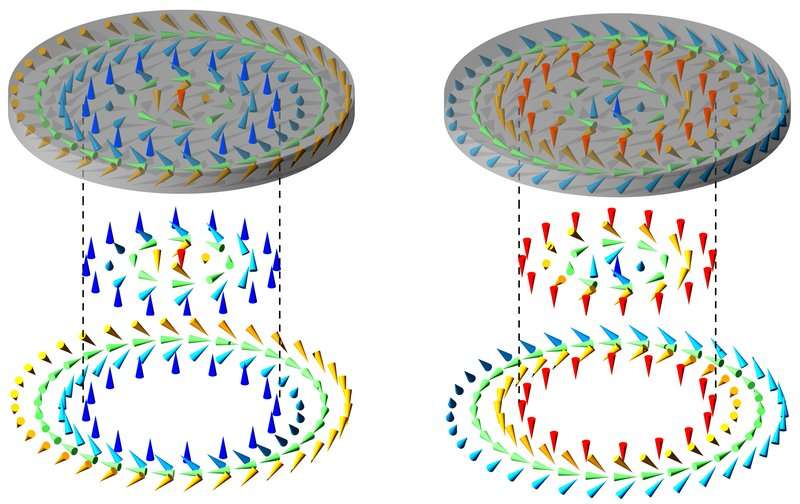November 16, 2017 report
Magnetic skyrmions found to hold the potential of storing electronic data

(Phys.org)—A team of researchers with members from the U.S., Germany and China has found that magnetic skyrmions could one day be used as a means of storing electronic data. In their paper published in the journal Physical Review Letters, the researchers describe creating a structure capable of generating skyrmions that can be reversed with a magnet while retaining its form as the magnet is withdrawn.
Skyrmions are swirling spins in a material that exist as a pattern, generally a circle, and are typically stabilized by use of an external magnet. In this new effort, the researchers developed a method by which skyrmions could be generated that do not require an external magnet to remain stable. Furthermore, they found that applying a magnet caused the skyrmion to reverse itself.
To generate a skyrmion, the researchers created an iron germanide disk (using ion beam milling and gas injection followed by etching) with a 160-nanometer diameter that was 90 nanometers thick. They then used electron holography to show that a skyrmion existed in the middle of the disk they had created. They also found that the outer part of the disk held electron spins that created a magnetic field that was opposite to that of the skyrmion. Further study of the structure they created showed that it had two lowest ground state configurations—one with the skyrmion rotating clockwise (with the spins pointing up), the other counterclockwise (with the spins pointing down). The skyrmion, they also found, could shift between the two states by temporarily applying a magnetic field as small as 200 millitesla. The stabilization, the researchers suggest, occurs because of the magnetic field generated by the outer ring of the disk
In noting that the skyrmion could be switched back and forth quickly and easily, the researchers suggest the structure could be applied in a replacement for conventional memory devices, because it is much smaller than ferromagnetics now in use. They also point out the possibility of using them to create logic gates. Techniques for simplifying and industrializing the process of creating the disks would have to be developed before implementation of such applications, however.
More information: Fengshan Zheng et al. Direct Imaging of a Zero-Field Target Skyrmion and Its Polarity Switch in a Chiral Magnetic Nanodisk, Physical Review Letters (2017). DOI: 10.1103/PhysRevLett.119.197205 . On Arxiv: arxiv.org/abs/1706.06923
ABSTRACT
A target Skyrmion is a flux-closed spin texture that has twofold degeneracy and is promising as a binary state in next generation universal memories. Although its formation in nanopatterned chiral magnets has been predicted, its observation has remained challenging. Here, we use off-axis electron holography to record images of target Skyrmions in a 160-nm-diameter nanodisk of the chiral magnet FeGe. We compare experimental measurements with numerical simulations, demonstrate switching between two stable degenerate target Skyrmion ground states that have opposite polarities and rotation senses, and discuss the observed switching mechanism.
Journal information: Physical Review Letters , arXiv
© 2017 Tech Xplore





















